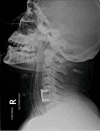Delayed spinal cord infarction following anterior cervical surgical decompression
- PMID: 28993348
- PMCID: PMC5652393
- DOI: 10.1136/bcr-2017-219863
Delayed spinal cord infarction following anterior cervical surgical decompression
Abstract
Anterior cervical discectomy and fusion (ACDF) for cord compression is a safe and effective procedure with good outcomes. However, worsening of myelopathy is the most feared adverse event of the surgery. We report the case of a 36-year-old male patient who presented with an acute non-traumatic C5-6 cervical disc herniation causing incomplete quadriparesis. He underwent an uncomplicated ACDF at C5-6, and after an initial period of improvement, he developed a delayed onset of an anterior cord syndrome on day 3, without any discerning cause. We have reviewed similar cases reported in the literature and believe that our patient's postsurgical course is consistent with a delayed ischaemic/reperfusion injury to the cord following surgical decompression and restoration of blood flow through the anterior spinal artery and we make suggestions for management of such clinical events.
Keywords: mechanical ventilation; neuroimaging; neurological injury; neurosurgery; spinal cord.
© BMJ Publishing Group Ltd (unless otherwise stated in the text of the article) 2017. All rights reserved. No commercial use is permitted unless otherwise expressly granted.
Conflict of interest statement
Competing interests: None declared.
Figures



Similar articles
-
A case report: white cord syndrome following anterior cervical discectomy and fusion: importance of prompt diagnosis and treatment.BMC Musculoskelet Disord. 2020 Mar 12;21(1):157. doi: 10.1186/s12891-020-3162-3. BMC Musculoskelet Disord. 2020. PMID: 32164644 Free PMC article.
-
'White Cord Syndrome': A Rare Catastrophic Complication Following Anterior Cervical Discectomy and Fusion.Neurol India. 2022 Sep-Oct;70(Supplement):S306-S309. doi: 10.4103/0028-3886.360940. Neurol India. 2022. PMID: 36412386
-
Two-level anterior cervical discectomy versus one-level corpectomy in cervical spondylotic myelopathy.Spine (Phila Pa 1976). 2009 Apr 1;34(7):692-6. doi: 10.1097/BRS.0b013e318199690a. Spine (Phila Pa 1976). 2009. PMID: 19333101
-
Delayed hyper-reactivity to metal ions after cervical disc arthroplasty: a case report and literature review.Spine (Phila Pa 1976). 2009 Apr 1;34(7):E262-5. doi: 10.1097/BRS.0b013e318195dd60. Spine (Phila Pa 1976). 2009. PMID: 19333091 Review.
-
Cervical Intradural Disc Herniation Causing Progressive Quadriparesis After Spinal Manipulation Therapy: A Case Report and Literature Review.Medicine (Baltimore). 2016 Feb;95(6):e2797. doi: 10.1097/MD.0000000000002797. Medicine (Baltimore). 2016. PMID: 26871842 Free PMC article. Review.
Cited by
-
Delayed Lower Extremity Monoplegia After Anterior Cervical Discectomy and Fusion: A Report of a Rare Case of Cervical Spinal Ischemic Reperfusion Injury.Cureus. 2024 Jul 22;16(7):e65071. doi: 10.7759/cureus.65071. eCollection 2024 Jul. Cureus. 2024. PMID: 39171027 Free PMC article.
-
Spinal cord infarction: A systematic review and meta-analysis of patient's characteristics, diagnosis accuracy, management, and outcome.Surg Neurol Int. 2024 Sep 13;15:325. doi: 10.25259/SNI_477_2024. eCollection 2024. Surg Neurol Int. 2024. PMID: 39372971 Free PMC article. Review.
-
White Cord Syndrome: A Reperfusion Injury Following Spinal Decompression Surgery.Korean J Neurotrauma. 2022 Jun 22;18(2):380-386. doi: 10.13004/kjnt.2022.18.e36. eCollection 2022 Oct. Korean J Neurotrauma. 2022. PMID: 36381466 Free PMC article.
-
Reperfusion Injury (RPI)/White Cord Syndrome (WCS) Due to Cervical Spine Surgery: A Diagnosis of Exclusion.Surg Neurol Int. 2020 Oct 2;11:320. doi: 10.25259/SNI_555_2020. eCollection 2020. Surg Neurol Int. 2020. PMID: 33093997 Free PMC article.
-
Cervical Spinal Cord Ischemic Reperfusion Injury: A Comprehensive Narrative Review of the Literature and Case Presentation.Cureus. 2022 Sep 3;14(9):e28715. doi: 10.7759/cureus.28715. eCollection 2022 Sep. Cureus. 2022. PMID: 36204035 Free PMC article.
References
-
- Goh HK, Li YH. Non-traumatic acute paraplegia caused by cervical disc herniation in a patient with sleep apnoea. Singapore Med J 2004;45:235–8. - PubMed
Publication types
MeSH terms
LinkOut - more resources
Full Text Sources
Other Literature Sources
Medical
Research Materials
Miscellaneous
